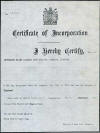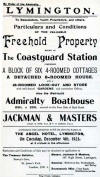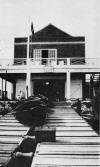The Development of the Club between the Wars:
click thumbnails below to enlarge
A Fresh Start:

Consolidation was the next step. It was proposed to try and buy the
Coastguard Boathouse, its slipway and site: the cost, £600. To raise the
money, the L.R.S.C. formed a limited company – the L.R.S.C. Building Company
Ltd.-with a capital of £1,500. In January, 1924, the Club bought the
property and immediately began to transform the boathouse: £1,253 was spent
on improvements. Members subscribed to a stake in their Club and many in due
course presented their shares to the L.R.S.C.
The Clubhouse: 1924:

The original structure consisted of one large section, purpose-built for the
Coastguard's boat; a small store-cum-workshop was divided off at the
landward end. Large double doors opened on to the slipway which sloped into
the river so that the boat could be launched at al! states of the tide. The
slipway was replaced, after Hitler's war, by our present pier.
Though the Clubhouse was shut for the winter, many fund-raising enterprises
were undertaken to pay off the building costs: from amateur dramatics to
hiring the premises for private parties. By March, 1929, the Clubhouse was
finally paid for and the Building Company liquidated.

In 1928, the membership had grown to 384; finances were adequate but the
capacity of the Clubhouse was not. The premises had to be enlarged. The old
building had a roof which, pitched at 30°, was slated. It was removed by the
builder, G. G. Harvey of Lymington, who then raised the walls to form the
large club room which later was to become the Reading Room. The original
timbers were re-used as far as possible, the pitch being increased to 45°
and plain tiles being laid. The heavy tie-beams and the unexpected
queen-trusses now visible in the reading room were the result. Considerable
improvements and additions were made to the ground floor. The balcony on the
first floor was open, as was the veranda underneath. The walls of that old
building erected during the last century still form part of the south wing
of today's modern structure.
The Club has been fortunate to include architects amongst its membership. In
1935-36 a north-south wing was added on the landward side; in March, 1938,
the wing was further extended to the northward to provide a boat store on
the ground floor, with the Ladies' Room above. A flagstaff and signal
cannons were provided during this period.



